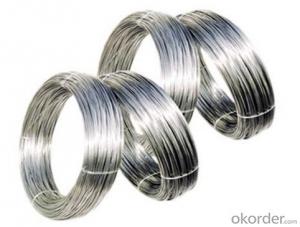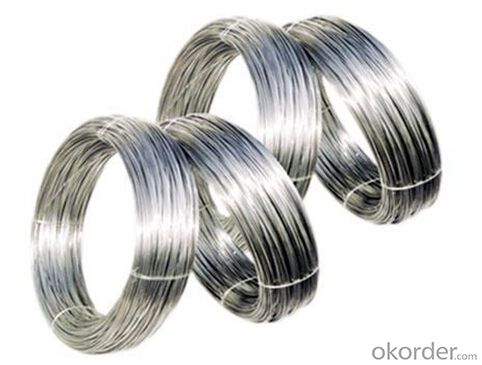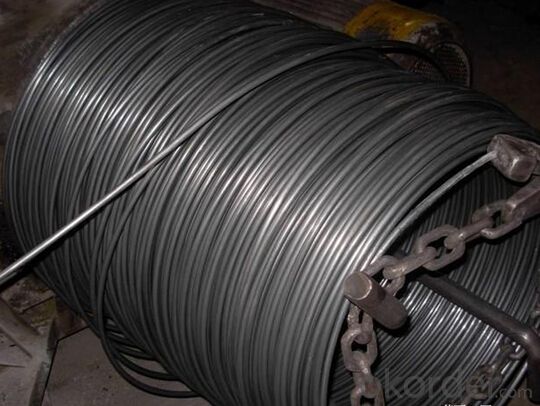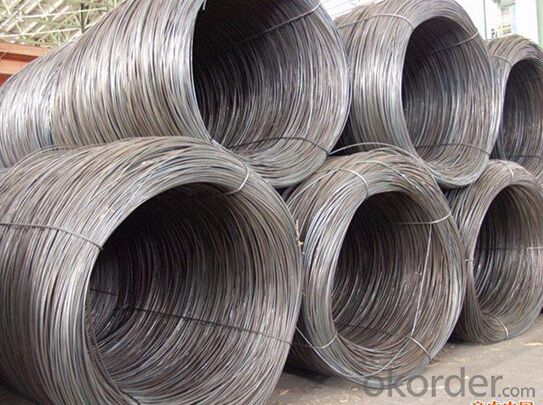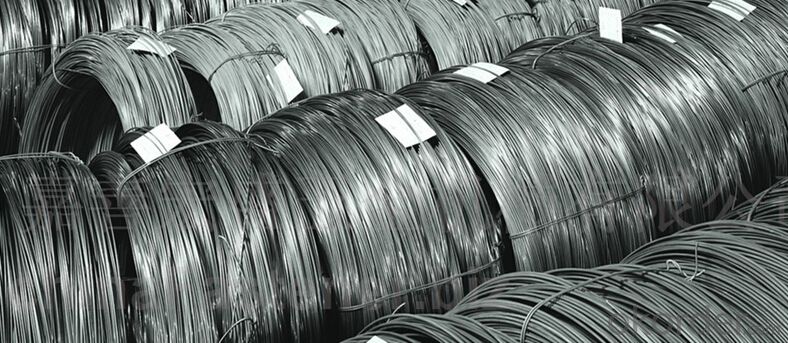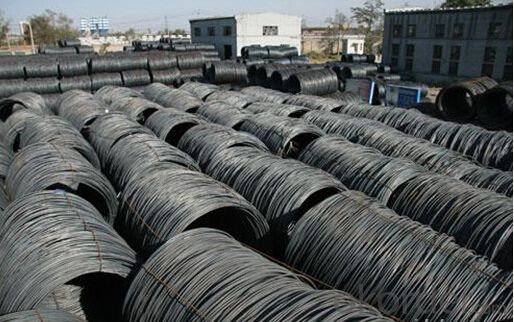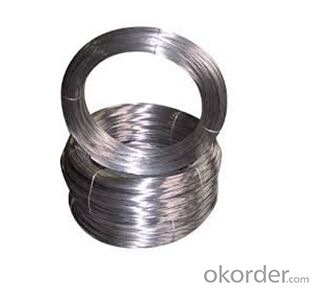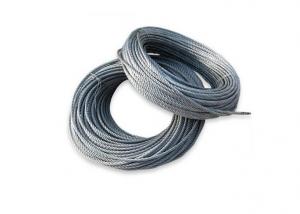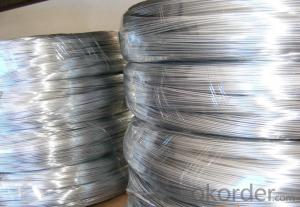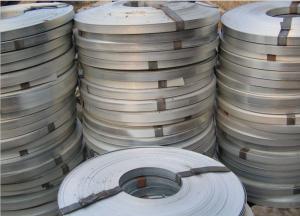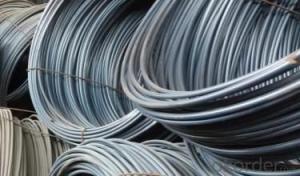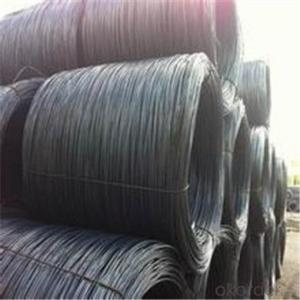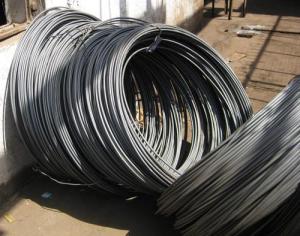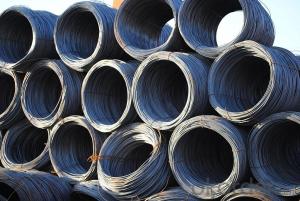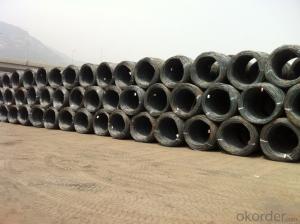Stainless Steel Wire Rod/ Dia 0.5mm Stainless Steel Wire
- Loading Port:
- Tianjin
- Payment Terms:
- TT OR LC
- Min Order Qty:
- 10 m.t.
- Supply Capability:
- 10000 m.t./month
OKorder Service Pledge
OKorder Financial Service
You Might Also Like
Specification
Stainless Steel Wire Rod/ Dia 0.5mm Stainless Steel Wire
Details of the Stainless Steel Wire Rod/ Dia 0.5mm Stainless Steel Wire
| Steel Grade | Q195-Q235,Q235,SAE 1008-1018 Hot Rolled Steel Wire Rod |
| Diameter | 5.5, 6.5, 7,8, 9,10, 12,14mm.etc. |
| Coil weight | 2m.t. |
| Application | drawing, construction materials, machinery parts,construction for Houses, Bridges, Roads,Packing |
| Deliver Time | 25-30 days after receipt of L/C or deposit by T/T |
| Packing | In coils, loading in container or by bulk vessel |
| Payment terms | 1).100% irrevocable L/C at sight. |
| 2).30% T/T prepaid and the balance against the copy of B/L. | |
| 3).30% T/T prepaid and the balance against L/C |
| Chemical Composition(%) | ||||||
| C | Mn | Si | S | P | Cr | |
| SAE1006B | 0.03~O.07 | ≤0.32 | ≤0.30 | ≤0.045 | ≤0.040 | 0.3-0.35 |
| Mechanical properties | ||||||
| Yield strength(N/mm2) | Tensile strength(N/mm2) | Elongation(%) | ||||
| 250-280 | 350-380 | ≥32 | ||||
| Grade | Chemical Composition(%) | |||||
| C | Mn | Si | S | P | Cr | |
| SAE1008B | 0.10max | 0.3~O.50 | 0.15max | 0.050max | 0.040 max | 0.3-0.35 |
| Mechanical properties | ||||||
| Yield strength(N/mm2) | Tensile strength(N/mm2) | Elongation(%) | ||||
| ≥195 | 315-430 | ≥30 | ||||
Supplier of the Stainless Steel Wire Rod/ Dia 0.5mm Stainless Steel Wire
CNBM International Corporation is the most import and export platform of CNBM group(China National Building Material Group Corporation) ,which is a state-owned enterprise, ranked in 270th of Fortune Global 500 in 2015.
With its advantages, CNBM International are mainly concentrate on Cement, Glass, Iron and Steel, Ceramics industries and devotes herself for supplying high quality series of refractories as well as technical consultancies and logistics solution.
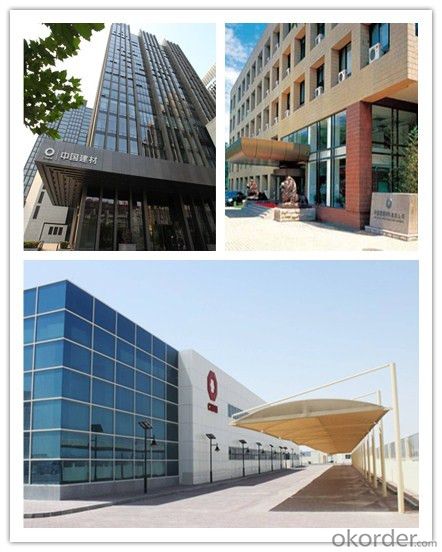

Delivery of the Stainless Steel Wire Rod/ Dia 0.5mm Stainless Steel Wire
Packaging Detail | Sea worthy packing /as per customer's packing instruction |
Delivery Detail | 15 ~ 40 days after receiving the deposit |
Products Show
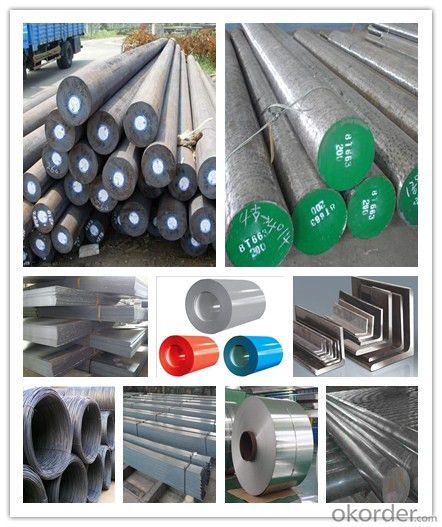
FAQ:
Are you a trading company or manufacturer? | Manufacturer |
What’s the MOQ? | 3 metric ton |
What’s your delivery time? | 15-35 days after downpayment received |
Do you Accept OEM service? | Yes |
what’s your delivery terms? | FOB/CFR/CIF |
What's the Payment Terms? | 30% as deposit,70% before shipment by T/T |
Western Union acceptable for small amount. | |
L/C acceptable for large amount. | |
Scrow ,Paybal,Alipay are also ok | |
Why choose us? | Chose happens because of quality, then price, We can give you both. Additionally, we can also offer professional products inquiry, products knowledge train (for agents), smooth goods delivery, excellent customer solution proposals. |
What's your available port of Shipment? | Main Port, China |
What’s your featured services? | Our service formula: good quality+ good price+ good service=customer's trust
|
Where are your Market? | Covering more than 160 countries in the world |
- Q: How are steel wire rods used in the production of barbed wire for security fencing?
- In the production of security fencing, steel wire rods are essential. They are used to create the twisted and sharp barbs that provide deterrence and protection. To begin the process, the steel wire rods are drawn through a series of dies. This reduces their diameter and increases their length, a process known as wire drawing. It improves the strength and durability of the wire. Once the wire rods have been drawn, they are twisted together to form a strong, continuous strand of wire. This twisted wire serves as the backbone of the barbed wire, providing stability and support. Next, the twisted wire is interwoven with sharp, pointed barbs. These barbs are made by cutting short lengths of the wire rods, sharpening the ends, and attaching them to the twisted wire at regular intervals. The placement and spacing of the barbs are strategic to maximize the security and deterrent effect of the barbed wire. After attaching the barbs, the barbed wire is typically galvanized to enhance its resistance to corrosion. The galvanization process involves coating the wire with a layer of zinc, providing a protective barrier against rust and environmental factors. This ensures the barbed wire remains strong and effective in various weather conditions. Once the galvanized barbed wire is produced, it can be wound onto spools or packaged in coils for easy transportation and installation. It is then ready to be installed as a security measure, typically on top of fences, walls, or other structures requiring additional protection. In conclusion, steel wire rods are crucial in the production of barbed wire for security fencing. They are transformed into twisted wire strands, which form the backbone of the barbed wire. Combined with sharp barbs, they create an effective deterrent. The use of steel wire rods ensures the barbed wire is strong, durable, and capable of withstanding harsh conditions, making it an essential component in security fencing systems.
- Q: What are the different surface inspection methods for steel wire rod?
- Steel wire rod can undergo a variety of surface inspection methods to ensure its quality and integrity. 1. The simplest and most basic method is visual inspection, where the surface is visually examined for visible defects like scratches, dents, or corrosion. 2. Another method is magnetic particle inspection, which involves applying a magnetic field and magnetic particles to the surface. Any defects or cracks cause the particles to cluster and become visible under UV light. 3. Eddy current testing is a non-destructive method that induces an electric current in the wire rod and measures the resulting electromagnetic field. Variations in the field can indicate surface defects. 4. Ultrasonic testing uses high-frequency sound waves to penetrate the surface. Defects or cracks reflect the sound waves, allowing for detection. 5. Dye penetrant inspection applies a liquid dye to the surface, which seeps into defects or cracks. After removing excess dye and applying a developer, the defects become visible. 6. Laser scanning is an advanced method that scans the surface using laser technology. It detects deviations from the normal surface profile and provides a detailed analysis. 7. X-ray inspection is used to inspect the internal and external surface of the wire rod. X-rays pass through the rod, and defects are detected by variations in the X-ray beam's intensity. Each method has its own advantages and limitations. The choice depends on specific requirements, the type of defects to be detected, and the desired level of accuracy.
- Q: What are the common production processes for molybdenum-coated steel wire rod?
- The common production processes for molybdenum-coated steel wire rod include cleaning and surface preparation, coating deposition through methods like electroplating or thermal spraying, and final finishing processes such as annealing and coating thickness control.
- Q: How is steel wire rod used in the manufacturing of cold heading quality wire?
- Cold heading quality wire, which is specifically designed for cold heading processes, relies heavily on steel wire rod as its essential raw material. This wire rod undergoes a meticulous selection process, where its chemical composition and mechanical properties are carefully evaluated to meet the required standards for cold heading applications. The rod is typically composed of low carbon steel, known for its exceptional formability and strength. Once the appropriate steel wire rod is chosen, it is subjected to heating at a specific temperature and subsequent rolling to achieve a smaller diameter. This process, referred to as hot rolling, enhances the wire rod's mechanical properties and surface finish. After being hot-rolled, the wire rod is cooled and straightened to eliminate any remaining stress and attain the desired shape and size. Following hot rolling, the steel wire rod undergoes a series of cold working operations. This includes drawing the wire rod through a sequence of dies to reduce its diameter and enhance its surface smoothness. Subsequently, the wire is annealed in order to restore its ductility and alleviate any internal stresses caused by cold working. Ultimately, the cold heading quality wire is coated with a lubricant to improve its formability and minimize friction during the cold heading process. This lubricant facilitates the wire's smooth flow through the cold heading machinery, ensuring it can be shaped into the desired fastener shape without any cracks or defects. To summarize, steel wire rod plays a vital role in the production of cold heading quality wire. Through a series of hot rolling, cold working, and coating processes, the wire rod is transformed into a wire that possesses the necessary mechanical properties, surface finish, and formability to manufacture high-quality fasteners.
- Q: Can steel wire rod be used in high-temperature applications?
- Yes, steel wire rod can be used in high-temperature applications. Steel has excellent heat-resistant properties and can withstand high temperatures without losing its strength or structural integrity. However, the specific grade and composition of the steel wire rod should be considered to ensure it is suitable for the intended high-temperature environment.
- Q: What are the common production processes for copper-coated steel wire rod?
- The common production processes for copper-coated steel wire rod typically involve wire drawing, cleaning, copper coating, annealing, and spooling.
- Q: What are the physical properties of a steel wire rod?
- The physical characteristics of a steel wire rod encompass its size, strength, toughness, pliability, and electrical conductivity. Size: Steel wire rods are available in a range of sizes and diameters, typically spanning from 5.5mm to 20mm. The length of the rod can vary depending on the manufacturer and intended use. Strength: Steel wire rods are renowned for their exceptional tensile strength, allowing them to withstand substantial loads and tension without fracturing or distorting. This strength is a product of the steel's composition and the manufacturing procedure. Toughness: Steel wire rods possess a specific level of toughness, which pertains to their resistance against indentation or scratching. The rod's hardness can be influenced by the type of steel alloy employed and any heat treatment methods employed during manufacturing. Pliability: Steel wire rods are recognized for their remarkable pliability and capacity to bend without breaking. This pliability stems from the inherent ductility of the steel material, enabling the rod to be shaped and employed in a variety of applications, including construction, automotive, and electrical industries. Electrical Conductivity: Steel wire rods exhibit excellent electrical conductivity, rendering them suitable for applications requiring the transmission of electrical energy or signals. However, it is crucial to note that steel is not as conductive as other metals such as copper or aluminum. In conclusion, steel wire rods are highly valued for their amalgamation of strength, toughness, pliability, and electrical conductivity, which renders them versatile and extensively utilized across various industries and applications.
- Q: How is steel wire rod used in the production of nails and fasteners?
- Steel wire rod is used in the production of nails and fasteners as it serves as the primary raw material for manufacturing these products. The wire rod is first drawn into the desired diameter and then cut into appropriate lengths. These lengths are then shaped, pointed, and threaded to create nails or fasteners. The strength and durability of steel wire rod make it an ideal material for producing reliable and sturdy nails and fasteners that can withstand heavy loads and provide secure fastening solutions in various industries.
- Q: How does the fatigue strength of steel wire rod vary with different diameters?
- The fatigue strength of steel wire rod generally decreases as the diameter of the rod increases.
- Q: How are steel wire rods used in the production of barbed wire?
- Steel wire rods are used in the production of barbed wire by being rolled and twisted together to form the central wire strand. This strand is then attached to sharp barbs, which are evenly spaced along the wire, creating the distinctive and effective deterrent of barbed wire.
Send your message to us
Stainless Steel Wire Rod/ Dia 0.5mm Stainless Steel Wire
- Loading Port:
- Tianjin
- Payment Terms:
- TT OR LC
- Min Order Qty:
- 10 m.t.
- Supply Capability:
- 10000 m.t./month
OKorder Service Pledge
OKorder Financial Service
Similar products
Hot products
Hot Searches
Related keywords
